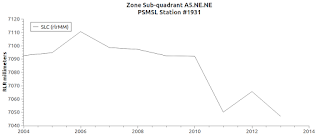 |
| Fig. 1 |
One of those seaports is the busiest in the whole world (Shanghai).
 |
| Fig. 2 |
The graph at Fig. 1 shows that the area is a high sea level rise area.
Which does not bode well for those seaports (The Extinction of Robust Sea Ports, 2, 3).
From 1940 - 2012 the SLR increase was 278 mm (~11 inches).
The temperature did not have a direct affect on the sea level there (Fig. 2), in terms of thermal expansion.
But the global warming heated the oceans enough to melt ice sheets from below the surface, as well as from the atmosphere above (Is A New Age Of Pressure Upon Us? - 8).
The next foot or two of sea level rise will take about half of that time.
The past few months have been crazy hot, in fact hotter than all other months in all of modern history:
"The combined average temperature over global land and ocean surfaces for February 2016 was the highest for February in the 137-year period of record, at 1.21°C (2.18°F) above the 20th century average of 12.1°C (53.9°F). This not only was the highest for February in the 1880–2016 record—surpassing the previous record set in 2015 by 0.33°C / 0.59°F—but it surpassed the all-time monthly record set just two months ago in December 2015 by 0.09°C (0.16°F). Overall, the six highest monthly temperature departures in the record have all occurred in the past six months. February 2016 also marks the 10th consecutive month a monthly global temperature record has been broken."(NOAA, Global Analysis - February 2016, emphasis added). Get ready for the doubling of sea level change.
With the crazoids wanting power so they can carpet bomb or nuke other nations, we also face a global cooling (Nuclear Winter, PDF).
You may wonder why warm melting ice and nuclear war winter are both subjects in this high sea level rise zone, which also contains the world's busiest seaport.
Note that Hiroshima and Nagisaki are both in this sub-quadrant (AL.SW.SW).
One side is ice, the other is fire up on this tight rope.
We never did make it here did we (You Are Here) ?
Tight Rope













